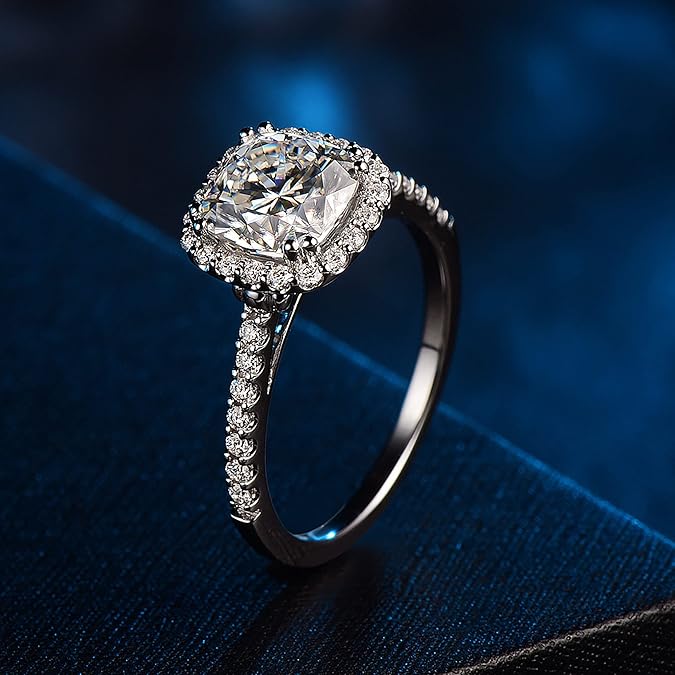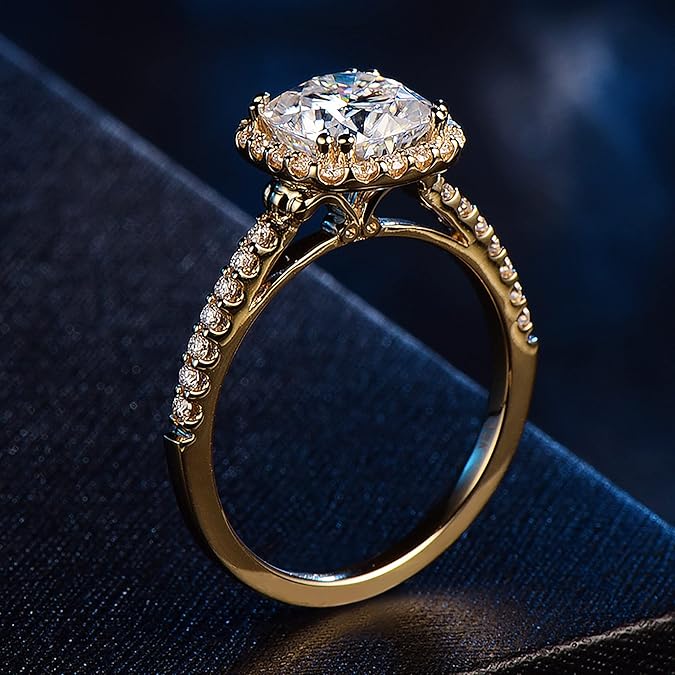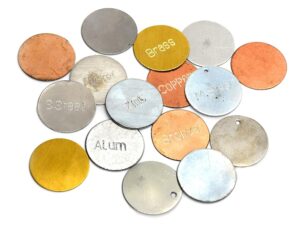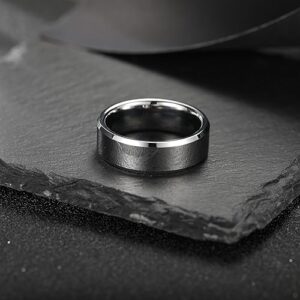Gold jewelry never goes out of style, but choosing between white gold and yellow gold can be tricky. Both are popular, yet different.This guide will help you decide by comparing their appearance, durability, care, value, and how they fit into different lifestyles.
By the end, you’ll know which gold suits your style and needs best.Stay with us, and let’s dive into the world of white gold and yellow gold!
Table of Contents
What Is White Gold?
When you hear “white gold,” you might imagine a shiny, silvery metal that looks a bit like platinum or sterling silver. But what exactly is white gold, and how does it compare to yellow gold?
What’s It Made Of?
White gold is a mixture of pure gold and other metals, like nickel or zinc, to give it that stunning silvery-white color. To make it even more shiny and durable, it’s often coated with a layer of rhodium, which is a shiny metal from the platinum family. This rhodium plating adds a brilliant finish, but it’s important to know that over time, this coating might wear off a little, especially if worn daily.
So yes, white gold is real gold, but it’s mixed with other metals to give it that distinct look. The gold content in white gold can vary depending on the karat (like 14k or 18k), but the main thing to remember is that it’s still gold at heart!
Why Is It So Popular?
One of the reasons white gold is so loved is because it’s sleek and modern. The cool-toned shine pairs perfectly with diamonds and other precious gemstones. It’s a favorite choice for engagement rings, as the white color brings out the sparkle of diamonds beautifully.
White gold’s contemporary vibe also makes it a popular choice for high-end, luxury jewelry. Whether it’s a simple pendant, a fancy bracelet, or a bold necklace, white gold adds elegance to any piece.

What Is Yellow Gold?
When you think of gold, the classic yellow gold often comes to mind. This warm, rich metal has been used for centuries in jewelry, and it still holds a timeless appeal today. But what exactly is yellow gold, and why do so many people choose it?
What’s It Made Of?
Yellow gold is made by mixing pure gold with copper and silver. These metals are blended together to create a beautiful warm, golden hue. The gold content can vary depending on the karat, with 14k and 18k being the most common choices for jewelry.
Unlike white gold, yellow gold doesn’t need any plating. Its warm yellow color is natural and doesn’t require any extra coatings to shine.
Why Is It So Popular?
Yellow gold is often considered the classic gold. Its rich, warm color has been loved for centuries, making it the perfect choice for vintage or traditional pieces. Whether it’s an heirloom ring or a custom-designed necklace, yellow gold offers a sense of history and timeless elegance.
It’s also easy to match with skin tones. The warm tones of yellow gold tend to flatter a wide range of skin types, whether you have fair, medium, or dark skin. It’s also a versatile option that pairs well with almost any outfit.

White Gold vs Yellow Gold
Choosing between white gold and yellow gold can feel like a tough decision, but breaking down the features can make it easier to find your perfect match. Let’s compare the two metals side-by-side based on some key factors.
1. Color
- White Gold: A silvery-white hue, which gives it a cool and modern appearance.
- Yellow Gold: A warm yellow tone that has a more traditional, rich feel.
2. Alloys Used
- White Gold is made from pure gold mixed with nickel or palladium for a silvery look, and often coated with rhodium for extra shine. For example, 14K white gold contains 58% gold and 42% metals like nickel, while 18K white gold has 75% gold and 25% other metals.
- Yellow Gold is made by combining pure gold with copper and silver to give it a warm, rich color. 14K yellow gold is 58% gold and 42% copper and silver, while 18K yellow gold is 75% gold and 25% copper and silver, offering a classic golden hue.
3. Durability
- White Gold: White gold is harder and more scratch-resistant, but the rhodium coating wears off over time and needs to be re-plated.
- Yellow Gold: Softer and more prone to scratches, but its natural color doesn’t need to be re-plated.
4. Skin Sensitivity
- White Gold: Nickel in white gold can cause allergic reactions for some people, so it might not be ideal for sensitive skin.
- Yellow Gold: More hypoallergenic because it doesn’t usually contain nickel, making it a better option for those with sensitive skin.
5. Maintenance
- White Gold: Requires more maintenance, especially rhodium re-plating every 1-2 years to maintain that shiny finish.
- Yellow Gold: Minimal maintenance, but might need a polish now and then to keep it looking great.
6. Cost
- White Gold: Slightly higher in price, due to the rhodium plating and alloy mix.
- Yellow Gold: Slightly lower cost, making it a more budget-friendly option.
7. Styling
- White Gold: Modern and chic, often used in engagement rings and contemporary jewelry.
- Yellow Gold: Vintage and classic, often associated with heirlooms, traditional designs, and timeless pieces.

Pros and Cons
White Gold
Pros:
- Modern, Sleek Appearance: White gold has a cool, silvery-white tone that looks chic and sophisticated, making it perfect for contemporary jewelry like engagement rings and luxury pieces.
- Durability: White gold is harder than yellow gold due to the alloyed metals like nickel. This makes it scratch-resistant, which is great for jewelry worn daily.
- Compliments Diamonds and Gemstones: The bright white hue of white gold enhances the sparkle of diamonds and colored gemstones, making it a top choice for jewelry with precious stones.
- Hypoallergenic Options: While it may cause nickel sensitivity in some individuals, many jewelers use palladium or other non-nickel alloys in their white gold, offering hypoallergenic options.
Cons:
- Needs Re-plating: White gold’s rhodium plating fades over time, requiring re-coating every 1-2 years to maintain its bright shine.
- Higher Cost: The rhodium plating and higher alloy content can make white gold slightly more expensive than yellow gold.
- Can Cause Nickel Allergy: Some white gold pieces may contain nickel, which can cause allergic reactions in sensitive individuals.
Yellow Gold
Pros:
- Timeless, Warm Appeal: Yellow gold has a classic, rich color that never goes out of style. It’s often used for vintage jewelry or heirloom pieces.
- Low Maintenance: Yellow gold doesn’t require re-plating, making it easy to maintain. A simple polish is usually enough to keep it looking shiny.
- Hypoallergenic: Since yellow gold is typically mixed with copper and silver, it’s less likely to cause an allergic reaction compared to white gold with nickel.
- Great for All Skin Tones: The warm hue of yellow gold flatters a wide range of skin tones, especially those with warm undertones.
Cons:
- Softness: Yellow gold is softer than white gold, so it may scratch more easily, especially with daily wear.
- Not as Modern: Some people prefer the sleekness of white gold, and yellow gold may seem too traditional or vintage for certain tastes.
- Prone to Dings: Since yellow gold is softer, it can be more prone to dents and dings when compared to white gold, particularly in rings and bracelets.
How to Choose: Factors to Consider
Choosing between white gold and yellow gold isn’t just about aesthetics—there are a few key factors that can help guide your decision. Let’s break them down so you can make an informed choice based on your unique needs.
Skin Tone
- White Gold: If you have cool undertones (fair skin with pink or blue tones), white gold will likely complement your complexion beautifully. Its silvery hue enhances the brightness of cool-toned skin.
- Yellow Gold: If you have warm undertones (skin with yellow or peachy tones), yellow gold will bring out the natural warmth of your skin. It flatters darker, warmer complexions with its rich golden color.
Jewelry Type
- White Gold: White gold is a perfect match for diamonds and modern, chic pieces. Its sleek appearance pairs beautifully with the brilliance of diamonds, making it a top choice for engagement rings and contemporary jewelry designs.
- Yellow Gold: Yellow gold shines in traditional and vintage designs. It’s often used for heirlooms, antique pieces, or any jewelry with a timeless appeal. If you want something that feels classic and nostalgic, yellow gold might be your best bet.
Lifestyle and Maintenance
- White Gold: White gold requires extra care due to the rhodium plating that can wear off over time. If you’re okay with re-coating every couple of years, this could work well for you.
- Yellow Gold: Yellow gold is lower maintenance—it doesn’t need re-plating, but it’s more prone to scratches since it’s a bit softer. If you lead an active lifestyle, you might need to polish it occasionally to keep it looking fresh.
Budget and Metal Allergies
- White Gold: White gold tends to be slightly more expensive because of the rhodium coating and alloy mix. Additionally, if you have a nickel allergy, white gold might not be ideal since it often contains nickel (especially in 14k and 18k options).
- Yellow Gold: Yellow gold is usually more affordable and is a safer option for sensitive skin. It’s naturally hypoallergenic and doesn’t usually contain nickel, making it a great choice if you’re prone to skin irritation.
Frequently Asked Question's
Yes, white gold is real gold! It’s a mixture of pure gold and other metals like nickel or zinc to create its unique silvery hue. The rhodium plating adds that extra shine, but the base is still gold.
White gold can tarnish a bit, especially because of the rhodium plating. Over time, this layer may wear off, and you might need to have it re-plated to maintain that fresh, shiny look. But don’t worry—this is normal for many white gold pieces, and it’s an easy fix at most jewelry stores.
It depends on personal preference! Yellow gold is more classic and has a warm, timeless appeal. It’s perfect for those who love traditional styles. White gold, on the other hand, offers a modern, sleek look, especially when paired with diamonds. Neither is “better”—it’s all about what suits your style!
To maintain white gold, it’s important to have it re-plated with rhodium every 1-2 years to keep the shine intact. Regular cleaning with mild soap and water will also help keep it looking great.
Yellow gold can lose some of its shine over time, especially with daily wear. However, regular polishing will help restore its beautiful luster and minimize scratches.
Yes, white gold can turn yellow over time, but it’s usually because the rhodium plating wears off. The gold underneath is still white, but the plating fades, giving it a yellowish look. A quick re-plating at the jeweler will restore its shine.
White gold is more durable because it’s mixed with harder metals, but it needs re-plating every 1-2 years. Yellow gold is softer and can scratch more easily, but it doesn’t need re-plating, so it’s lower maintenance.
If you prefer low-maintenance jewelry, yellow gold is a good choice. If you want durability and shine, white gold is better.
White gold itself isn’t considered haram in Islam. However, if it’s mixed with certain metals like platinum or rhodium, or if it’s used in a way that contradicts Islamic values (like excessive luxury or waste), then it could be a concern. Generally, gold in any form is allowed, but the intention and usage matter.
White gold is typically more expensive than yellow gold. This is because white gold is often alloyed with other metals like platinum or palladium to give it its color, which can increase the cost. Additionally, white gold often requires rhodium plating, which adds to its price.
Diamonds tend to look better in white gold because the cool, silvery tone of white gold enhances the diamond’s brilliance and sparkle. The color contrast makes the diamond stand out more.
However, if you’re going for a warmer, vintage, or classic style, yellow gold can complement diamonds beautifully, especially in certain cuts or with warmer-toned diamonds. The choice depends on personal preference and the overall look you desire!
To test if jewelry is made of white gold, you can perform a few simple checks:
Magnet Test: White gold is not magnetic, so if a magnet attracts the jewelry, it’s likely not white gold.
Hallmark: Look for a stamp like “10K,” “14K,” or “18K” which indicates the purity of the gold.
Color and Finish: White gold often has a silver-like appearance, but it’s usually coated with rhodium, which makes it look shiny and bright. If the coating wears off, the metal beneath will have a yellowish tint.
For more precise testing, you may want to take your jewelry to a jeweler for an assay.
Conclusion: Which Is Right for You?
Choosing between white gold and yellow gold can feel like a big decision, but the truth is—there’s no wrong choice! It all comes down to what suits your style, budget, and personal needs. Whether you prefer the sleek, modern vibe of white gold or the warm, classic look of yellow gold, both metals are beautiful, versatile, and timeless in their own ways.
Recap: Find Your Perfect Match
- White Gold is perfect if you love a cool, modern aesthetic, especially if you’re drawn to engagement rings or luxury jewelry with diamonds and gemstones.
- Yellow Gold, with its rich, warm hue, is ideal if you appreciate vintage or classic designs or want a piece that’s easy to match with different skin tones.
💬 What About You?
Which gold would you choose—white or yellow?
👉 Comment below and let us know your favorite!



